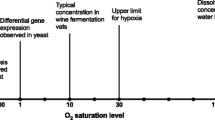Summary
-
1.
Growing cultures of Saccharomyces cerevisiae, S. oviformis, Escherichia coli, Aerobacter aerogenes, Pseudomonas spec. and Lactobacillus brevis produce trace amounts of CO (0.4–2.6 ppm) that can be detected in the gas space above the cultures using a sensitive analytical method based on the reaction CO+HgO→CO2+Hg. The liberated Hg is quantitatively measured by atomic absorption at 2537 Å. No CO could be detected above cultures of Lactobacillus arabinosus, Bacillus cereus var. mycoides and Aspergillus niger.
-
2.
The maximum CO production by Saccharomyces was obtained with concentrations of 10–50 g glucose per liter medium. The amount of CO formed increased with the oxygen concentration in the gas space above the cultures.
-
3.
Using 14C-glucose it was shown that S. cerevisiae forms CO from glucose.
-
4.
The formation of CO by the microorganisms investigated is very small. The ratio of CO/CO2 produced is much smaller than in environmental air. Therefore it can be concluded that the production of CO by these microorganisms has probably no significance for the atmospheric cycle of this trace gas.
Zusammenfassung
-
1.
Mit einer empfindlichen Analysenmethode, die auf die Reaktion CO+HgO→CO2+Hg basiert und den CO-Gehalt auf Grund der Absorption des freigesetzten Hg bei 2537 Å ermittelt, wurden im Gasraum über wachsenden Kulturen von Saccharomyces cerevisiae, S. oviformis, Escherichia coli, Aerobacter aerogenes, Pseudomonas spec. und Lactobacillus brevis 0.4–2.6 ppm CO nachgewiesen. Bei Lactobacillus arabinosus, Bacillus cereus var. mycoides und Aspergillus niger war eine CO-Bildung nicht meßbar.
-
2.
Bei S. cerevisiae war die CO-Bildung bei Konzentrationen von 10–50 g Glucose pro Liter Medium am größten. Außerdem wurde die CO-Bildung proportional zum anfänglichen Sauerstoffgehalt im Gasraum über den Kulturen gefördert.
-
3.
Mit 14C-markierter Glucose wurde nachgewiesen, daß CO aus Glucose entsteht.
-
4.
Die CO-Bildung der untersuchten Mikroorganismen ist so gering, daß sie keine Bedeutung für den Kreislauf dieses Spurengases in der Atmosphäre hat.
Similar content being viewed by others
Literatur
Bidwell, R. G. S., Fraser, D. E.: Carbon monoxide uptake and metabolism by leaves. Canad. J. Bot. 50, 1435–1439 (1972)
Chapman, D. J., Tochter, R. D.: Occurrence and production of carbon monoxide in some brown algae. Canad. J. Bot. 44, 1438–1442 (1966)
Chappelle, E., Krall, A.: Carbon monoxide fixation by cell free extracts of green plants. Biochim. biophys. Acta (Amst.) 49, 578–580 (1961)
De Man, J. C., Rogosa, M., Sharpe, M. E.: A medium for the cultivation of lactobacilli. J. appl. Bact. 23, 130–135 (1960)
Engel, R. R., Matsen, J. M., Chapman, S. S., Schwartz, S.: Carbon monoxide production from heme compounds by bacteria. J. Bact. 112, 1310–1315 (1972)
Engel, R. R., Modler, S., Matsen, J. M., Petryka, Z. J.: Carbon monoxide production from hydroxocobalamin by bacteria. Biochim. biophys. Acta (Amst.) 313, 150–155 (1973)
Hirsch, P.: Photosynthetic bacterium growing under carbon monoxide. Nature (Lond.) 217, 555–556 (1968)
Inman, R. E., Ingersoll, R. B., Levy, E. A.: Soil, a natural sink for carbon monoxide. Science 172, 1229–1231 (1971)
Junge, C., Seiler, W., Bock, R., Greese, K. D., Radler, F.: Über die CO-Produktion von Mikroorganismen. Naturwissenschaften 58, 362–363 (1971)
Junge, C.: The cycle of atmospheric gases-natural and man made. Quart. J. roy. Met. Soc. 98, 711–729 (1972)
Junge, C., Seiler, W., Schmidt, U., Bock, R., Greese, K. D., Radler, F., Rüger, H. J.: Kohlenmonoxid- und Wasserstoffproduktion mariner Mikroorganismen im Nährmedium mit synthetischem Seewasser. Naturwissenschaften 59, 514–515 (1972)
Kistner, A.: Conditions determining the oxidation of carbon monoxide and of hydrogen by Hydrogenomonas carboxydovorans. Proc. Sect. Sci. 57, 186–195 (1954)
Loewus, M. W., Delwiche, C. C.: Carbon monoxide production by algae. Plant Physiol. 38, 371–374 (1963)
Miyahara, S., Takahashi, H.: Biological CO evolution: Carbon monoxide evolution during autoenzymatic oxidation of phenols. J. Biochem. (Tokyo) 69, 231–233 (1971); zit. Biol. Abstr. 54, 41130 (1972)
Pickwell, G.: Physiology of carbon monoxide production by deep-sea coelenterates: causes and consequences. Ann. N.Y. Acad. Sci. 174, 102–115 (1970)
Seiler, W., Junge, C.: Carbon monoxide in the atmosphere. J. Geophys. Res. 75, 2217–2226 (1970)
Troxler, R. F.: Inexpensive technique for measuring carbon monoxide formation in plants. Plant Physiol. 48, 376–378 (1971)
Westlake, D. W. S., Roxburgh, J. M., Talbot, G.: Microbial production of carbon monoxide from flavonoids. Nature (Lond.) 189, 510–511 (1961)
Wittenberg, J.: The source of carbon monoxide in the float of the Purtugese Man-of-War, Physalia physalis L. J. exp. Biol. 37, 698–705 (1960)
Author information
Authors and Affiliations
Rights and permissions
About this article
Cite this article
Radler, F., Greese, K.D., Bock, R. et al. Die Bildung von Spuren von Kohlenmonoxid durch Saccharomyces cerevisiae und andere Mikroorganismen. Arch. Microbiol. 100, 243–252 (1974). https://doi.org/10.1007/BF00446321
Received:
Issue Date:
DOI: https://doi.org/10.1007/BF00446321



